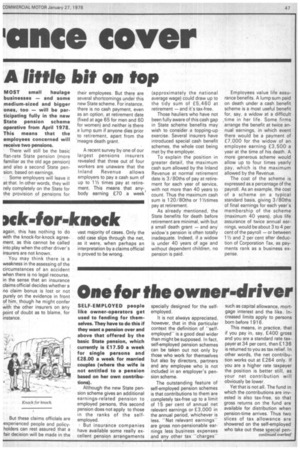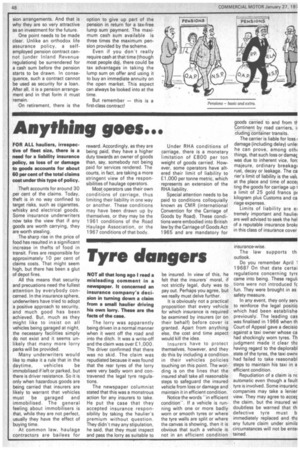One for the owner-driver
Page 49

Page 50

If you've noticed an error in this article please click here to report it so we can fix it.
SELF-EMPLOYED people like owner-operators get used to fending for themselves. They have to do this if they want a pension over and above that offered by the basic State pension, which currently is £17.50 a week for single persons and £28.00 a week for married couples (where the wife is not entitled to a pension based on her own contributions).
Although the new State pension scheme gives an additional earnings-related pension to employed persons, this second pension does not apply to those in the ranks of the selfemployed.
But insurance companies have available some really excellent pension arrangements specially designed for the selfemployed.
It is not always appreciated, however, that in this particular context the definition of "selfemployedis a good deal wider than might be supposed. In fact, self-employed pension schemes can be taken out not only by those who work for themselves but also by directors, partners and any employee who is not included in an employer's pension scheme.
The outstanding feature of self-employed pension schemes is that contributions to them are completely tax-free up to a limit of 15 per cent of annual net relevant earnings or £3,000 in the annual period, whichever is less. "Net relevant earnings"' are gross non-pensionable earnings less business expenses and any other tax "charges' suchas capital allowance, mortgage interest and the like. Increased limits apply to persons born before 1916.
This means, in practice, that if you pay in, say, E400 gross and you are a standard rate taxpayer at 34 per cent, then £136 is returned to you as tax relief. In other words, the net contribution works out at £264 only. If you are a higher rate taxpayer the position is better still, as your net contribution will obviously be lower.
Yet that is not all. The fund in which the contributions are invested is also tax-free, so that gross returns on the fund are available for distribution when pension-time arrives. Thus two slices of tax allowance are showered on the self-employed who take out these special pen
sion arrangements. And that is why they are so very attractive as an investment for the future.
One point needs to be made clear. Unlike an orthodox life assurance policy, a selfemployed pension contract cannot (under Inland Revenue regulations) be surrendered for a cash sum before the pension starts to be drawn. In consequence, such a contract cannot be used as security for a loan. After all, it is a pension arrangement and in that form it must remain.
On retirement, there is the option to give up part of the pension in return for a tax-free lump sum payment. The maximum cash sum available is three times the maximum pension provided by the scheme.
Even if you don't really require cash at that time (though most people do), there could be tax advantages in taking the lump sum on offer and using it to buy an immediate annuity on the open market. This aspect can always be looked into at the time.
But remember — this is a first-class contract!




















































































































